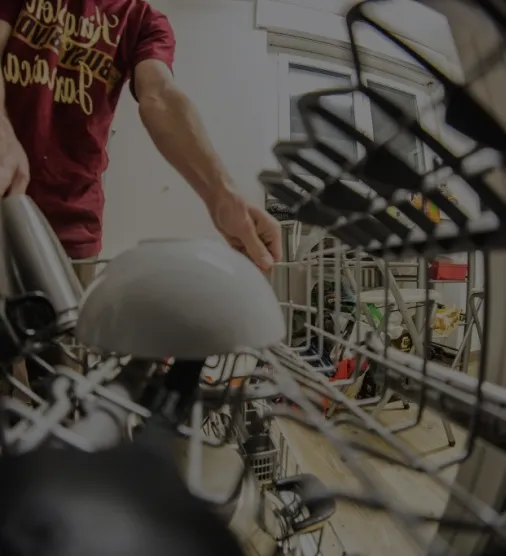Call Us Now: (587) 952 7077
Opening Hours: Mon - Fri: 7am - 7pm; Saturday: 7am - 3 pm
Call Us Now: (587) 952 7077
Opening Hours: Mon - Fri: 7am - 7pm; Saturday: 7am - 3 pm

How do you check if the dishwasher is clogged? You’re likely dealing with a clogged dishwashing machine if your drain isn’t working well and if water collects on the bottom for an inch. It’s the last thing anyone wants to deal with a smelly and malfunctioning dishwasher. Who has time or flexibility to wait for a service technician who will only come out and clean their dishes if the dishwasher works? You can troubleshoot your dishwasher to clear it before calling for a pro. Start troubleshooting by selecting a topic.
There are many reasons your dishwasher will not drain. A clogged filter most often causes clogs in dishwashers. Your dishwasher may clog due to an air gap, exhaust, drain hose, or garbage disposal issue.
Be sure to empty your dishwasher and disconnect it from the power source before you begin troubleshooting. You can only thoroughly inspect your dishwasher if it is empty.
Then, empty any standing water from your dishwasher. It will be easier to troubleshoot if you can see the drain. Remove excess water from the cup and soak the remaining liquid with towels, wet/dry shop vacuums, or even a sponge and turkey baster. To prevent water leaking on your floor, place paper towels or cloth around the base of your dishwasher.
A dirty filter is the most common cause of drainage problems in dishwashers. Filters can become clogged with food particles such as popcorn kernels and wet pieces of label paper. This prevents water from draining from your dishwasher. Dish soap can cause the dishwasher to overflow.
Remove the bottom dish rack, and then look at the bottom of your tub. The filter assembly can be found in the back corner of some models. In others, it is near the base spray arm.
Often, the filter is covered by a grille or cage. Most dishwasher filters can be removed by hand. However, some may require a screwdriver. After removing the cover, you can remove the filter. If yours is clogged, you’ll see visible food particles, dirt, or other debris in the fine mesh.
The filter can be rinsed under the faucet to remove most soils. Use a soft toothbrush to scrub away caked-on dirt. Use a soft brush, not a hard or abrasive one. You could damage the filter. When you are done, replace the filter with a new one that is sparkling clean, and secure the cage or grille.
You may need to clean your filter if the drain is still clogged after washing it.
Sometimes, glass can break inside the dishwasher, and small debris can enter the drain pump outlet. Remove the drain pumps and vacuum out the area. Replace the drain pumps.
The garbage disposal is usually the drain for built-in dishwashers. If you still have a clogged dishwasher, it could be this. Start your garbage disposal and clear any leftovers. If your garbage disposer makes a loud noise when you turn it on, it could be clogged. You’ll also need to troubleshoot. Have you recently installed or serviced the garbage disposal? Check if the knockout drainage on the dishwasher has been removed. This is often overlooked when diagnosing a clogged washer.
Air gaps in dishwashers allow air to flow into the unit so that it drains properly and without creating a vacuum. This air gap is on the top of your sink. It allows only air to pass through. The air gap in your sink can get clogged up or blocked, which will cause drainage problems. Clean out any debris in the air gap of your sink and secure it tightly.
Make sure your drain hose is securely attached to the sink. The drain hose is located either under the sink or behind the dishwasher. It connects your dishwasher to the garbage disposal or sink. Ensure the drain hose is free of debris or food if adequately secured. You can use a drain cleaner or make your own to clean your hose. Baking soda mixed with vinegar can be used to clean drains naturally. You may need a more powerful drain cleaner if the clogs are urgent. Recently, did you redo your kitchen plumbing system? A poorly installed drain hose is often the cause of a dishwasher that won’t drain. Drain hoses may kink when being installed, causing the pump not to drain. Sometimes, a drain pipe has a check valve built for a one-way flow. It is installed backward. Follow the instructions to replace the drain tube if you installed the dishwasher. A clogged drain hose will restrict flow.